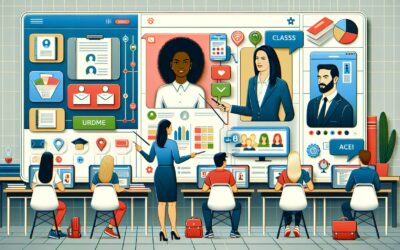Beyond Textbooks & Videos: 5 Ways AR is Transforming Learning Landscape
How millennials and Gen Z learn and work is changing at a fast pace. Their learning preference includes video-based learning and hands-on experiences delivered through multiple training formats. As expected, they also show great comfort in handling advanced technologies such as Augmented Reality (AR) and Virtual Reality (VR). According to a recent report by PwC, 79% of CEOs worldwide worry that lacking essential workforce skills could hinder their company’s future growth. Therefore, it is necessary for L&D leaders to completely move from outdated training methods to digital training environments using AR technology to drive workforce skill development.
Rising Scope of AR in Workplace Learning
AR has gained momentum as an efficient training tool in every industry. It is a strong step forward taken by companies as a substitute for the traditional classroom training approach, where learners would spend countless hours learning from text-savvy manuals and boring PowerPoint slides. This environment still exists but has improved with the rising popularity of AR in eLearning. By incorporating AR into online training programs, companies can:
- Enhance the speed of the corporate training process
- Boost the efficiency of the training program
- Update online content whenever needed as per the tailored needs
- Encourage skill development at reduced training costs
- Undergo training in a risk-free environment
You might wonder if AR is all about Snapchat filters or Pokémon Go. Today, many organizations have realized the potential of AR for hands-on skill development training. AR is useful in real-life applications, from entertainment to training, to boost employee skills in dynamic work environments. Five ways that AR can revolutionize the training experience include the following:
- Realistic Training Simulations: With AR, workplace training leaps into the real world with virtual scenarios, providing an immersive learning experience. Learners can gain hands-on experience by practicing procedures and navigating complex scenarios in a risk-free setting. For instance, healthcare professionals can practice complex surgeries in a risk-free environment, or salespeople can fine-tune their pitches for every customer encounter.
- On-the-Job Performance Support: With AR, learners get quick access to relevant training materials for on-the-job guidance whenever and wherever they need it. Imagine a field technician arriving at the customer’s site to repair a piece of machinery. They scan the equipment, and the AR application provides step-by-step instructions on their smartphones. This ensures higher accuracy, lower downtime, and more adherence to safety procedures.
- Interactive Guides & Visual Overlays: AR manuals overlay 3D models directly onto products or machinery instead of boring text and flat images. This enables employees to analyze situations in real-time, reducing the chances of errors and improving knowledge. In addition, AR also overlays the product packaging for enhanced customer understanding and retention.
- No Geographical Barriers with Remote Collaboration: AR in eLearning enables learners and trainers to interact in real-time, irrespective of their diverse geographical locations. With AR technology, experts can handle troubleshooting issues, offer guidance, and demonstrate complicated procedures from a distance. Imagine doctors across different hospitals discussing complex cases using AR simulation, which saves travel costs, improves accessibility, and encourages teamwork.
- Real-time Feedback: AR technology also enables trainers to assess learner performance by tracking their actions and giving real-time feedback. This mechanism fosters continuous improvement and allows learners to work on their weak areas and improve their skills when necessary.
Conclusion
AR can aid companies in boosting training efficiency, educating employees, and skyrocketing their performance by enhancing skills. While the technology may be costly to implement, it helps save time and cost in the long run. If you want to implement this technology, determine your training requirements and incorporate AR training into your workplace training strategies
Our News
- AI
- Animations
- Articulate
- Articulate 360
- Articulate Engage
- Articulate Live
- Articulate Presenter
- Articulate Quizmaker
- Articulate Replay
- Articulate Review
- Articulate Storyline
- Articulate Storyline 3
- Articulate Studio
- bite sized learning
- Characters
- Content Library
- Corporate Communication
- E-Learning
- e-Learning Authoring Tools
- Employee Engagement
- Game-Based Learning
- Gamification
- Gamiflexer
- Go Sales
- Healthcare
- Instructional Design
- Interactivity
- Knowledge Transfer
- L&D Trends
- Learning
- Learning & Development
- Learning Experience platform
- Learning Management System
- LMS
- LXP
- Microlearning
- mLearning
- Mobile Learning
- Nugget Learning
- Online Training
- Peek
- Performance Support
- Preso
- Quiz and Assessment Platform
- Replay 360
- Rise
- SCORM
- Screen Capture
- Software
- Storyline 360
- Studio 360
- Training Management
- Trainings
- Uncategorized




